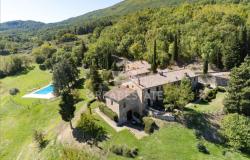Straddling the central Italian regions of Marche and Umbria, the National Park of the Sibillini Mountains protects the mountain chain of the same name, which includes the highest peak of the Umbria-Marche Apennines, the Monte Vettore (2476m), and the surrounding hilly landscape, dotted with medieval villages, castles and abbeys, farms and cultivated fields.
The three major earthquakes that struck central Italy in 2016, the first one on August 24, and then again on October 26 and 30, hit hard on these areas; towns like Arquata del Tronto and Castelluccio, both located inside the national park, were completely or largely destroyed. Many trails and agriturismi were closed because deemed unsafe, causing added suffering to an area that bases most of its economy on tourism.
The residents who have not left, believing in the value of their region, in its natural beauty and centuries-old traditions, have gotten together to find ways to rebuild and attract tourists again. Almost two years later, 90% of accommodation facilities within the park have reopened, and most trails have as well.
I was recently able to experience the resilience of the local residents and how the park is accessible again on a press tour organized by local journalists, bloggers, hiking guides, agriturismo and mountain hut owners who, without any form of compensation or help from tourism boards or the region, took a group of journalists on a tour of the Monti Sibillini National Park, #ripartidaisibillinipress.
Our first stop was in the small medieval town of Amandola, one of the major historic and cultural centers of the park and a good base when exploring the area, with a large number of accommodation options. Access into the pleasant historic center is through a crenellated gate. From a gastronomic standpoint, Amandola is renowned for its white truffle and the pink apple of the Monti Sibillini, a Slow Food presidium.

[Amandola.]
Near the town, at the foot of Mount Amandola, is the Rifugio Città di Amandola, managed by the friendly Edgardo Giacomozzi, who welcomed us in for a glass of the local spumante Alta Marea, made with the local vine variety Passerina, and for a platter of the local pecorino of the Sibillini and of the ciauscolo, a smoked and dry-cured sausage, made from pork meat, which is to be rubbed on bread.
Open year-round, the Rifugio Città di Amandola (1200m) is a good starting point for several hikes towards some of the park’s highest peaks, Monte Castel Manardo (1917m), Pizzo Tre Vescovi (2092m), and Monte Priora (2332m). It is also a stop on the long-distance trek ‘Grande Anello dei Sibillini,’ a 120-km loop that encompasses the entire mountain chain of the Sibillini and is a wonderful opportunity to discover the variety of landscapes, flora and fauna that are protected in the park.
The valley floors of many rivers and streams form narrow and impressive gorges, like the Gole dell’Infernaccio, natural canyons carved by the river Tenna, one of the most popular destinations in the park, which reopened mid-April after being closed off for safety reasons following the earthquake.
The stretch of the river inside the gorges is set among high and steep walls of limestone mountains, immersed in a dense and lush beech wood.

[Gole dell'Infernaccio. Photo credit: Andrea Braconi.]
The trail is currently open until the junction for the 11th-century Eremo di San Leonardo, erected on a large plain at 1120 meters of altitude; the hermitage site was, for centuries, and still is today, a popular destination for pilgrims and wanderers. The eremo is reached in about an hour from the junction.
The Gole dell’Infernaccio are located between the Monte Priora and Monte Sibilla. The Sibilla is one of the most famous mountains in the park as it is related to the legend of the Apennine Sibyl (Sibilla), the fabled dweller of the homonymous cave located near the summit of the mountain. It can only be reached on foot.
Indeed the Sibillini have a magical feel to them, perhaps enhanced by the beliefs and legends passed down since the Middle Ages, which told of mysterious figures whose aura still linger.
The whole area at the foot of the Sibilla takes the name of Valleria, as this was the place where, according to local lore, shepherds and the fairies who belonged to the court of the Sibilla (they lived with her in the cave) gathered for their dances (balli in Italian, modified into valli in the local dialect, which tends to transform the B in V in many cases).
On the flanks of these mountains were the ancient paths that led to the Strada delle Fate (the ‘Fairies Road’); the story goes that one night the fairies, who inhabited the Sibyl's Cave, hung around longer than usual to dance with the young men of Pretare and, before dawn could catch them, fled so quickly that they left their footprints on the mountain, thus creating their ‘road’, strada.
Mysticism is another aspect of these mountains, where there are numerous sanctuaries, including one that risked crumbling down after the earthquake, the Sanctuary of Madonna dell’Ambro, which for centuries was a spiritual reference for a vast population. It is the oldest sanctuary in Le Marche, built in 1073, second for the number of visitors only to Loreto.

[Anti-seismic measures are being implemented on the Sanctuary of the Madonna dell'Ambro. Photo credit: Andrea Braconi.]
The Chapel of the Annunciation houses several 17th century paintings depicting biblical and pagan prophecies related to the figure of the Madonna. What is most striking is the number of painted sibyls compared to prophets, 12 to 4.
The sanctuary of the Madonna dell’Ambro is still closed to the public; renovation and seismic reinforcement measures, financed by local bank Carifermo, and implemented by local construction company Alessandrini, are scheduled to be completed by the end of 2018.
From the spiritual to worldly it’s a short step, but it would be inaccurate not to mention the Chioschetto del Bosco, a restaurant next to the sanctuary where our group of journalists was treated to a lunch feast of local salumi (cold cuts) and cheese platters, different types of pasta, including tagliatelle with mushroom and ravioli served with truffle, and local wine.
Fortunately, there’s always a trail to work off the food. Another popular hike, which takes about 2.30 hours to complete, is the one departing from the Lago di Fiastra, an artificial lake, to the Lame Rosse, geological formations shaped like pinnacles and towers by the erosion of wind and rain. The last stretch of the hike is a bit steep, but relatively short and highly recommended so that you can admire the Lame Rosse up close from below.

[Journalists attending the press tour #ripartidaisibillinipress below the Lame Rosse. Photo credit: Andrea Braconi.]
Within the Sibillini Mountains National Park is Castelluccio di Norcia, sadly damaged by the earthquake to the point that all the residents had to be evacuated. At 1452 m, Castelluccio is the highest settlement in the Apennines, and lies above the ‘Great Plain’ (Piano Grande - 1270 m), one of three plains in Castelluccio, the other two being Pian Piccolo and Pian Perduto; they are karstic plateaus, once the bottom of an ancient Apennine lake. Made of limestone, they hold underground reserves of water; from late May to July, the plains transform into a colorful carpet of flowers, when lentils (for which Castelluccio is famous), poppies, cornflowers, daisies, and more, bloom.

[Castelluccio's plain in full bloom.]
And because in the Sibillini a good place to eat and rest is never too far away, check out Rifugio Belvedere at Forca di Presta (the pass that divides Marche from Umbria), managed by Andrea Salvatori, who supervises a number of mountain huts in the park, Rifugi dei Sibillini; just another example of locals who are determined to move on and welcome visitors back to their region.
Where to sleep:
La Conca, Smerillo (Fermo)
Bellavista, Monte San Martino (Macerata)
La Querceta, Amandola (Fermo)
Fillide, Amandola (Fermo)
Le Castellare, Montemonaco (Ascoli Piceno)
or check out the Sibillini Segreti e Sapori Association
Where to eat:
Agriturismo Santa Lucia dei Sibillini
Mountain huts:
For more information on the National Park of the Sibillini Mountains, click here.












